
The former president Trump made a threat to incite Russia to launch an attack on NATO allies that fail to make their payments on time. “Appalling and unhinged” is how the White House described the comments.
When former US President Donald Trump implied that he would even encourage Russia to attack its members if they didn’t pay enough on defense, it set off a chain reaction of criticism from the White House and senior Western leaders.
These are the answers to some key questions about NATO, the comments made by Trump (who is now lagging President Joe Biden in certain polls and is running for reelection in November), and the implications of those answers.
Table of Contents
NATO: WHAT IS IT?

A political and military alliance of nations from North America and Europe, the North Atlantic Treaty Organization was established in 1949 in response to growing Cold War tensions with the Soviet Union.
Article 5 of its founding treaty enshrines the idea of collective defense, which holds that an attack on one member is considered an attack on all of them.
NATO members decide by agreement, although the United States is by far the most dominant nation in the organization due to its political and military might, with its nuclear weapons seen as the ultimate security assurance.
WHICH NATIONS ARE PART OF IT?
Currently, the United States, Canada, and most European countries make up the organization’s 31 members.
Finland is the newest member, having joined in April of last year in response to Russia’s invasion of Ukraine in 2022. Sweden, Finland, and other countries applied to join, but the last significant step before joining is for Hungary to confirm Sweden’s application.
It’s primary goal during the Cold War was to defend Western Europe from the Soviet Union. It was enlarged to include nations from Central and Eastern Europe that had been part of the communist bloc following the collapse of the Berlin Wall in 1989.
Large nations like Germany, France, Turkey, and the United Kingdom are among NATO’s members, as are smaller ones like Iceland and Montenegro.
ABOUT NATO, WHAT DID TRUMP SAY?

During his tenure as U.S. president from 2017 to 21, Trump frequently attacked NATO and its allies, including Germany, charging them with underfunding their defense and depending too much on Washington for security. He publicly questioned the idea of collective defense.
Though in less direct language, other U.S. administrations have also charged Europeans with underspending on defense.
At a Saturday campaign rally in Conway, South Carolina, Trump escalated his attack by relating an account of what he claimed to have been a chat with the “the president of a big country”.
“Well sir, if we don’t pay, and we’re invaded by Russia – will you protect us?” Trump cited the unidentified leader’s words.
“‘You didn’t pay?’ I asked. You’re a miscreant? “Yeah, let’s say that happened,” he responded. I wouldn’t shield you, no. Actually, I would say let Russia do whatever the hell it wants. You have to pay,” Trump declared.
Describe NATO Article 5.
NATO members said in Article 5 of the founding treaty that any armed attack in Europe or North America “shall be considered an attack against them all.”
They made a commitment to “assist the Party or Parties so attacked by taking forthwith, independently and in concert with the other Parties, such action as it determines necessary, including the use of armed force” .
Article 5 does not, however, obligate nations to launch an immediate military reaction to support an ally that is being attacked. Thus, the potency of Article 5 hinges on unequivocal declarations from political figures that it would be supported by measures.
Trump’s remarks sparked a lot of controversy for this reason, especially since they were made during a period when it was particularly alarmed about Russia’s intentions in light of its invasion of Ukraine.
The presumptions that underpin Article 5 were called into question by Trump when he hinted that he would not use force to defend an ally.
It’s Secretary General Jens Stoltenberg stated on Sunday that “any suggestion that allies will not defend each other undermines all of our security, including that of the U.S. and puts American and European soldiers at increased risk.”
HOW IT IS FINANCED ?
As a result of Trump’s frequent accusations that other of its members are not paying their dues, the alliance has been compared to a club with dues.
However, it functions in a distinct manner. Each member contributes to a certain amount of common cash. However, the great majority of its power originates from national defense spending by its members, who utilize it to purchase weapons and retain forces that NATO can also use.
The majority of its countries failed to fulfil their annual defence spending target last year, despite their commitment to allocating at least 2% of their GDP to the military.
ABOUT HOW MANY MEMBERS ACHIEVE THE DEFENCE SPENDING TARGET?
11 members were predicted by NATO projections, opens new tab from July of last year, to fulfill the 2% objective in 2023. Poland, the US, Greece, Estonia, Lithuania, Finland, Romania, Hungary, Latvia, Britain, and Slovakia were among those members.
The economic powerhouse of Europe, Germany, was expected to be 1.57%. However, German officials have stated that they anticipate meeting the 2% target this year, in part because of a unique fund worth one billion euros that was set up in reaction to Russia’s conflict in Ukraine.
Based on GDP as a percentage of GDP, Luxembourg, Belgium, and Spain were the least spenders, according to its data.
According to those familiar with the statistics, NATO is anticipated to issue updated information in the coming days that will show more nations meeting the 2% threshold.


